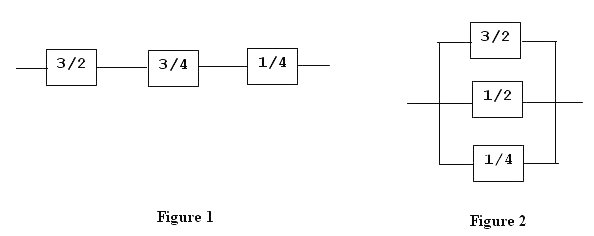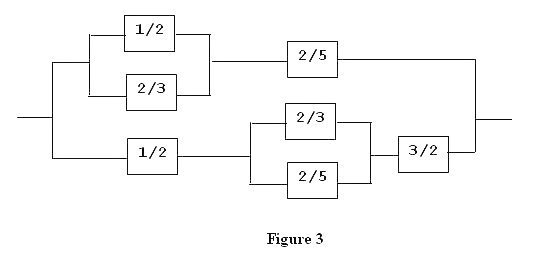当前你的浏览器版本过低,网站已在兼容模式下运行,兼容模式仅提供最小功能支持,网站样式可能显示不正常。
请尽快升级浏览器以体验网站在线编辑、在线运行等功能。
3429:Resistors
题目描述
Every electrical appliance (such as a light bulb) has a certain resistance. If the appliance is connected to a given voltage, the higher its resistance, the lower the current flowing through the appliance. The unit of measurement for resistance is the ohm. In order to avoid round-off errors that can affect floating-point numbers, we will use rational numbers (quotients of positive integers) to represent the resistance of an appliance numerically. There are two basic ways to connect two or more appliances into a configuration of
appliances: serially (Figure 1) or parallel (Figure 2). Two or more configurations can be further connected serially or parallel to yield another
(more complex) configuration yet, and this process of building more complex configurations from existing ones can be repeated any number of times (Figure 3). In general, a configuration is either a single appliance, or a serial connection of two or more configurations, or a parallel connection of two or more configurations. The resistance of a configuration of resistors can be computed according to the following
two rules:
1. The resistance of a serial configuration is the sum of the resistances of its component
configurations.
2. The resistance of a parallel configuration is the reciprocal of the sum of the
reciprocals of its component configurations.

In Figure 1, the resistance of the configuration is 3/2 + 3/4 + 1/4 = 5/2 ohm.In Figure 2, the resistance of the configuration is 1/(1/(3/2) + 1/(1/2) + 1/ (1/4)) = 3/20 ohm

In Figure 3, we first calculate 1/(1/(1/2) + 1/(2/3)) + 2/5 = 24/35 and 1/2 + 1/(1/(2/3) + 1/(2/5)) + 3/2 = 9/4. Adding the reciprocals of these two values and reciprocating the result, we get 72/137 ohm.
A configuration can be represented in text format.
*A single appliance is represented by the numerical value of its resistance (without enclosing parentheses).
*A configuration that is the serial connection of several configurations is represented as a list of the representations of its components, separated by the ampersand character ("&") and enclosed in a pair of parentheses.
*A configuration that is the parallel connection of several configurations is represented as a list of the representations of its components, separated by the vertical bar character ("|") and enclosed in a pair of parentheses.
Thus, figures 1, 2, and 3 are represented in text format by the respective expressions:
(3/2 & 3/4 & 1/4)
(3/2 | 1/2 | 1/4)
(((1/2 | 2/3) & 2/5) | (1/2 & (2/3 | 2/5) & 3/2))
appliances: serially (Figure 1) or parallel (Figure 2). Two or more configurations can be further connected serially or parallel to yield another
(more complex) configuration yet, and this process of building more complex configurations from existing ones can be repeated any number of times (Figure 3). In general, a configuration is either a single appliance, or a serial connection of two or more configurations, or a parallel connection of two or more configurations. The resistance of a configuration of resistors can be computed according to the following
two rules:
1. The resistance of a serial configuration is the sum of the resistances of its component
configurations.
2. The resistance of a parallel configuration is the reciprocal of the sum of the
reciprocals of its component configurations.

In Figure 1, the resistance of the configuration is 3/2 + 3/4 + 1/4 = 5/2 ohm.In Figure 2, the resistance of the configuration is 1/(1/(3/2) + 1/(1/2) + 1/ (1/4)) = 3/20 ohm

In Figure 3, we first calculate 1/(1/(1/2) + 1/(2/3)) + 2/5 = 24/35 and 1/2 + 1/(1/(2/3) + 1/(2/5)) + 3/2 = 9/4. Adding the reciprocals of these two values and reciprocating the result, we get 72/137 ohm.
A configuration can be represented in text format.
*A single appliance is represented by the numerical value of its resistance (without enclosing parentheses).
*A configuration that is the serial connection of several configurations is represented as a list of the representations of its components, separated by the ampersand character ("&") and enclosed in a pair of parentheses.
*A configuration that is the parallel connection of several configurations is represented as a list of the representations of its components, separated by the vertical bar character ("|") and enclosed in a pair of parentheses.
Thus, figures 1, 2, and 3 are represented in text format by the respective expressions:
(3/2 & 3/4 & 1/4)
(3/2 | 1/2 | 1/4)
(((1/2 | 2/3) & 2/5) | (1/2 & (2/3 | 2/5) & 3/2))
输入解释
The input consists of a number of test cases, one test case per line. Each line of the input contains a valid expression that defines a configuration according to the rules stated above. The resistance values of the appliances will be positive rational numbers, in the form NUMERATOR/DENOMINATOR. There will be one blank space on each side of every ampersand or vertical bar. There will be no other blank spaces in the expression.
输出解释
For each test case, print the resistance of the configuration on a new line, in the form NUMERATOR/DENOMINATOR, with all common factors of NUMERATOR and DENOMINATOR cancelled. Do not print any blank spaces.
输入样例
15/1 (3/2 & 3/4 & 1/4) (3/2 | 1/2 | 1/4) ((1/2 | 2/3) & 2/5) (1/2 & (2/3 | 2/5) & 3/2) (((1/2 | 2/3) & 2/5) | (1/2 & (2/3 | 2/5) & 3/2))
输出样例
15/1 5/2 3/20 24/35 9/4 72/137
来自杭电HDUOJ的附加信息
| Recommend | zhouzeyong |
最后修改于 2020-10-25T23:03:26+00:00 由爬虫自动更新
共提交 0 次
通过率 --%
| 时间上限 | 内存上限 |
| 2000/1000MS(Java/Others) | 32768/32768K(Java/Others) |
登陆或注册以提交代码